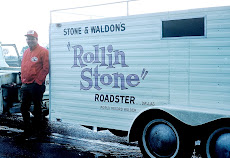The how and why I got started collecting old radios should be obvious to you if you have been following my blog for anytime. I spent thirty years behind microphones at various radio stations around the country, and despite working in television for fifteen of those years, the older medium has always been my favorite.
My oldest radio is a 1937 Philco cathedral-back model. Actually, Philco calls it a model 31-71. I bought it in Dallas back in 1971 and it was in a cardboard box in three pieces. While refinishing the cabinet I tried to replace some of the defective tubes. Two area service dealers sent me to the national warehouse for Philco as I tried to find the main power supply tube. When I relayed the number of the tube I waited 'on hold' for ten minutes while the technician traced it down. He told me this tube had been on the shelf for over twenty years and he was sending it to me free for putting one of their old units back in service. It still works and has a nice bass sound to it...
The old stand-up, or floor model, radios have always been enchanting for me. I was raised by my grandmother while my Dad was gone to World War II and my Mother worked two jobs to support our family. Each day and night my grandmother and I would sit before her Atwater-Kent radio and listen to soap operas by day and mysteries at night. The model above is a 1940 RCA Victor radio that I discovered in 1973. The previous owner told me it did not work and gave me a discounted price. This particular radio receives standard broadcast signals, but also shortwave transmissions. He had the knob turned to shortwave and when I got home I switched it to AM and the radio played like brand new. I have done some refinishing to the cabinet and speaker cloth.
Another of my floor models is this 1942 Truetone radio. It features an AM, FM, and shortwave band of reception. This particular model has a longwire antenna that needs to be stretched out to receive distant signals. I have never had occasion to listen to the shortwave band, but the AM and FM bands work like new.
This is a 1948 Westinghouse table model radio, and was one of the first to have push-button tuning. I had planned to restain the cabinet when I got it sanded down, but the natural wood is from three different varieties so I just clear coated it and painted the trim. This radio receives not only the standard broadcast band, but the 19, 25, and 31 meter bands of shortwave. Most of the broadcasts from overseas during World War II came to America via shortwave.
Finally we have my 1946 RCA Radiola... I wanted a radio that did not have a wooden cabinet so I could paint it this color. This was a bakelike finish and I sanded it down smooth and painted the background of the dial a lighter color so the tuning needle would stand out. When I purchased if off of Ebay it looked like this.

But with three coats of Chevrolet engine orange it now adorns our bookshelf looking like this:

The knobs got a touch-up of dark brown paint and my talented wife did the Radiola script for me. This one does not work, but I simply wanted it as a display model for the bookshelf. Needless to say, everyone notices it as soon as they come in the room.









No comments:
Post a Comment